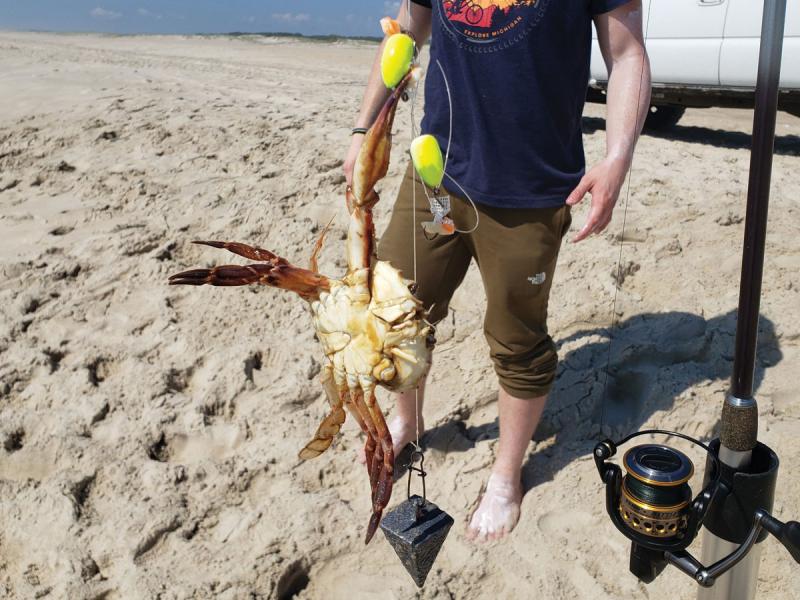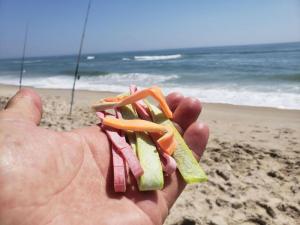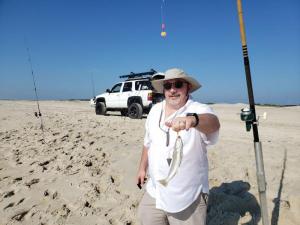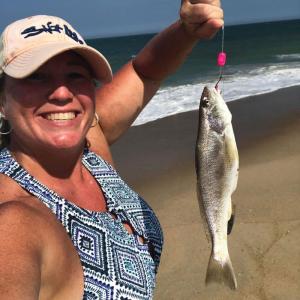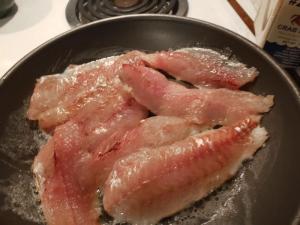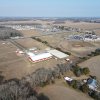The fishing is hot to not; put in the time
That heat wave though! It has been brutal, so we fish at night, predawn and are home by early morning to get back into the air conditioning. It has been a little rough some days; be sure to stay hydrated and look to your people and pets for heat exhaustion signs. That happens fast this time of year. It will not be nearly as bad this weekend.
The fishing is hot to not, you just have to put in that time. Last Wednesday we went to Assateague and found a nice spot with fish signs on the beach. We set up and hammered spot and kingfish for hours. It was a fun day; it’s always fun when you are catching. I had the old 13-foot honey Lamiglass set up with an old Penn greenie reel - the ones that sound like a coffee grinder when you reel. It is great for the small surf fishing; the rod is from the 70s and she still has a little back bone to her. We took turns reeling that beast in because after the third time you don’t want to pick up the 50-year-old rod that weighs like a ton of bricks. It isn’t the actual issue of weight; it is the fact that the old Penn reel has about a one to zero gear ratio. It takes forever and a day to reel in a normal cast, compared to a reel of today that takes seconds. For a difficulty bonus, the reel is taped to the rod butt; there isn’t a reel seat. This rod was made by an old Montauk surf caster it was not built for bait and wait comfort. I like using it in the summer for fun and it still functions. It reminds me of being out with my grandfather when I was a kid, especially that coffee grinder reel sound.
The fishing is better offshore for flounder than inshore or along the beaches and coastal waterways. The weekends are pretty crowded too, which makes for tougher fishing the closer you are to shore. The hot weather helps because it forces earlier and later trips which produce more catches. It’s the best time to fish this time of year.
There are a lot of white perch in the Broadkill river and kingfish are thick at times in the surf, spot as well. These all make for great table fare, with fish tacos for days. I like to just use what we catch that day and never really freeze any of the smaller fish. The meat will keep a couple days in the fridge. As long as I can bail a dozen or so a week, I have plenty of fish to eat. The grill is waiting for my favorite summer beach snack. The pompano are showing in the Outer Banks more and more, so not long now. I’m just curious to see what other fish we see this summer. A triple tail or two would be nice.
A friend of mine is trying to talk me into a fly-fishing trip down south for tarpon outside Virginia. I just got a few new long rod wizard wands and need to break them in first, but that sounds like fun. Fly fishing the surf is fun in the early mornings, and productive. I don’t care what the tide is early mornings; everything wakes up and feeds. On really flat calm days you can see so much action on the water at the beach. There are schools of bait fish cruising along, then they’re pushed up by predators. It helps determine where to cast at times.
There are lots of sheepshead on the rocks, wrecks and reefs. Ribbonfish are abundant for the offshore anglers going for sea bass or flounder. Those are tasty fish for sure.
The slot striped bass fishing in the Delaware Bay and its tributaries has been decent action; there’s lots of fat bass for the dinner plate this summer. Use swim shads or small bucktails in tandem for the lure anglers. Sand fleaing for bass is fun on ultralight gear. Catch a bucket full of fleas and hit the Lewes Canal or Roosevelt Inlet.
If you are clamming the inland bays, make sure you follow the DNREC maps for restricted areas. Those areas are closed due to bacteria levels which are harmful for consumption and in some cases exposure to open wounds. There are maps in the fishing guide. There are usually signs telling about closed areas, but these tend to disappear during storms.
The tuna action offshore has been great for many of the boats. Check for trips as they are booking up fast it seems. Again, weekdays are the best for more action and less company out there, but that never guarantees a good catch.
Testing tackle at Assateague with DS Custom Tackle owner David Okonewski, who offered the following story, explaining why his crew makes its rigs a certain way: “So as the crew were out on the sand doing some product reliability testing, we stumbled upon a chance to prove a point as to why we make our rigs the way we do.
As we all know there are multiple ways to make dropper loop rigs, hi-lo rigs or whatever you’d like to call them. Some people cut the loop and snell a hook onto the mono. We prefer to put the hook directly on to the dropper loop, cross it over and lock the hook in place. Surprisingly, we get a lot of flak about how we do this, but today provided us a real-world chance to show why it’s superior.
At about 9:30 a.m., we got a double hook up of a nice kingfish and a little lady crab on our pompano rig. The crab, doing crab things, broke one the side of the dropper loop. However, the hook remained in place on a now technically broken rig. So, we wagered amongst ourselves how long the hook would stay in place. We all lost that bet. Cast after cast, fish caught after fish caught the hook never moved.
As we were packing up for the morning, the rig was still there, catching fish. This proved the point that the way we do things, while it may appear different on the surface, is for a good reason. That reason is that our rigs will keep you on the fish, whether whole or broken, longer than anyone else’s.”
Get out and fish. The point will be open in about five weeks. I’m looking forward to the fall fishing, but I would like summer to slow down a bit.














